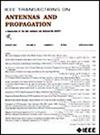Wideband Decoupling Circuit for Sub-6 GHz Co-Polarized In-Band Full-Duplex Patch Antennas
IF 4.6
1区 计算机科学
Q1 ENGINEERING, ELECTRICAL & ELECTRONIC
引用次数: 0
Abstract
To minimize the mutual coupling between co-polarized aperture-coupled patch antennas used in full-duplex applications, a novel decoupling method is introduced. This method involves creating an additional transmission bridge between the apertures of the two antenna elements at the feeding layer, effectively canceling the mutual coupling at the center frequency. The transmission bridge comprises two key components, which are a coupling structure connecting the aperture to a fork-shaped branch line, and a cancellation circuit. Notably, the cancellation circuit boasts wideband magnitude and phase compensation capabilities, providing a broadband decoupling response. Furthermore, it does not require any additional impedance-matching structures. To demonstrate the effectiveness, aSub-6 GHz共极化带内全双工贴片天线的宽带去耦电路
为了减小全双工应用中共极化孔耦合贴片天线之间的相互耦合,提出了一种新的解耦方法。该方法涉及在馈电层的两个天线元件的孔径之间创建一个额外的传输桥,有效地消除了中心频率处的相互耦合。传输桥包括两个关键部件,即连接孔径至叉形分支线的耦合结构和对消电路。值得注意的是,抵消电路具有宽带幅度和相位补偿能力,提供宽带去耦响应。此外,它不需要任何额外的阻抗匹配结构。为了验证其有效性,设计、制作并测试了工作在5.0 GHz的$1\ × 2$共极化贴片天线阵列。测量到的阵列端口到端口隔离超过50 dB,分数带宽为14.0%。尽管使用损耗电阻,但插入损耗小于0.88 dB。这些结果强调了所提出的耦合消除方法的优点,它提供了宽带宽、低姿态和简单的设计过程。
本文章由计算机程序翻译,如有差异,请以英文原文为准。
求助全文
约1分钟内获得全文
求助全文
来源期刊
CiteScore
10.40
自引率
28.10%
发文量
968
审稿时长
4.7 months
期刊介绍:
IEEE Transactions on Antennas and Propagation includes theoretical and experimental advances in antennas, including design and development, and in the propagation of electromagnetic waves, including scattering, diffraction, and interaction with continuous media; and applications pertaining to antennas and propagation, such as remote sensing, applied optics, and millimeter and submillimeter wave techniques

 求助内容:
求助内容: 应助结果提醒方式:
应助结果提醒方式:


